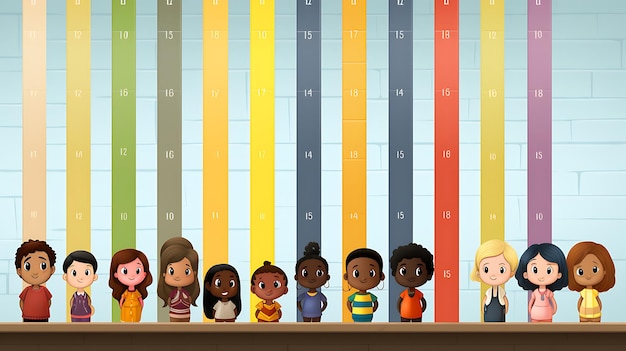College Graduation Rates: Latest Trends and Demographic Insights

What the Latest Data Reveals About College Graduation Rates Across Different Demographics indicates disparities persist among different racial, ethnic, and socioeconomic groups, underlining the need for targeted interventions to promote equity in higher education.
Understanding what the latest data reveals about college graduation rates across different demographics is crucial for addressing inequalities in higher education and creating opportunities for all students to succeed. Let’s delve into the key trends and challenges facing college students today.
Analyzing Overall College Graduation Rates
The overall college graduation rate provides a broad perspective on the success of students completing their higher education. Examining this metric helps to understand the general trends and challenges within the educational system. However, it is essential to delve deeper to uncover the complexities of graduation rates across various demographic groups.
National Averages and Trends
Looking at national averages can give an idea of how many students are finishing college. However, these numbers often don’t show the whole picture.
- The national graduation rate for four-year colleges is around 60%.
- Completion rates vary significantly between institutions and states.
- There has been a slow but steady increase in graduation rates over the past few decades.
Understanding these averages can provide a starting point for more detailed analysis.

Overall graduation rates give a starting point, but looking deeper shows there are differences in graduation rates between different demographic groups, pointing to areas where support is needed.
Graduation Rates by Race and Ethnicity
Graduation rates differ significantly among racial and ethnic groups. These disparities highlight the systemic challenges and inequities that students from underrepresented backgrounds often face in higher education. Understanding these differences is critical for developing targeted strategies to promote equity and improve outcomes for all students.
Comparison of Different Groups
Different groups of students have varying rates of finishing college. For example:
- Asian students generally have the highest graduation rates.
- White students have higher graduation rates than Black and Hispanic students.
- Native American students often have the lowest graduation rates.
These differences can be attributed to several factors, including socioeconomic status, access to resources, and institutional support.

Racial and ethnic disparities in college graduation rates can be attributed to historical and ongoing systemic issues. Addressing these gaps requires comprehensive strategies that include financial aid, academic support, and culturally responsive programs.
Impact of Socioeconomic Status on Graduation
Socioeconomic status is a significant predictor of college graduation rates. Students from low-income backgrounds often face numerous challenges that hinder their ability to complete their degrees, including financial constraints, lack of access to resources, and inadequate preparation. Understanding these challenges is essential for designing effective interventions to support these students and improve their graduation rates.
Financial Barriers and Support Systems
Money problems can make it tough for students to finish college. Things like tuition costs, living expenses, and paying for textbooks can be hard to manage.
- Many low-income students work long hours to pay for college, which can affect their studies.
- Financial aid and scholarships can help reduce the financial burden.
- Emergency grants and other support programs can provide assistance during unexpected financial crises.
These support systems can make a big difference for students who are worried about money.
Addressing financial barriers is crucial for improving graduation rates among low-income students. Increased funding for financial aid programs, affordable housing options, and access to resources like food banks can alleviate some of the financial pressures these students face.
Gender Differences in College Completion
Gender differences in college completion rates reveal interesting trends, with women often outperforming men in terms of graduation rates. However, it is important to consider the nuances within different fields of study and demographic groups. Analyzing these trends can provide insights into the factors that contribute to these differences and inform strategies to support all students.
Trends in Different Fields of Study
When it comes to finishing college, there are gender differences.
Historically, men have been more likely to pursue degrees in STEM (science, technology, engineering, and mathematics) fields.
However, women have made significant gains in these areas in recent years and may outnumber men in some fields.
Understanding these trends can help colleges better serve their students.
Analyzing gender differences in college completion rates can inform strategies to promote gender equity in higher education. Encouraging more men to seek support services and creating inclusive environments for women in STEM fields can help close these gaps.
The Role of Institutional Support
Institutional support plays a crucial role in student success and graduation rates. Colleges and universities that provide comprehensive support services, including academic advising, tutoring, mentoring, and mental health services, are more likely to see higher graduation rates among their students. Understanding the impact of institutional support is essential for creating a supportive and inclusive campus environment.
Effective Programs and Services
Support from colleges can really help students do well. Some helpful services include:
Academic Advising – Helping students choose the right courses and stay on track. This can mean giving advice on what classes to take or figuring out a career path.
Tutoring Services – Providing extra help with tough subjects.
Cultural Centers and Affinity Groups – Helping students connect with others who share their background and identity.
Colleges that put effort into these programs often see better results for their students.
Institutional support systems play a critical role in helping students overcome challenges and achieve their academic goals. Investing in comprehensive support services is essential for creating a campus environment that fosters student success.
Strategies for Improving Graduation Rates
Improving college graduation rates requires a multifaceted approach that addresses the various challenges students face. Implementing targeted interventions, creating supportive environments, and fostering a sense of belonging can help students succeed and complete their degrees. Understanding effective strategies is essential for creating a more equitable and successful higher education system.
Targeted Interventions and Support
To help more students finish college, here are some strategies:
Early Intervention Programs – Helping students who are struggling early on.
Mentoring Programs – Pairing students with mentors who can provide guidance and support.
Financial Literacy Education – Teaching students how to manage their money.
By using these strategies, colleges can help more students graduate.
Targeted interventions and support services play a critical role in helping students overcome obstacles and achieve their academic goals. By implementing these strategies, colleges and universities can create a more equitable and successful higher education system.
| Key Point | Brief Description |
|---|---|
| 📊 Overall Rates | National averages are around 60% for four-year colleges. |
| 🌍 Ethnicity Impacts | Asian students have the highest rates, while Native American students have the lowest. |
| 💰 Socioeconomics | Low-income students face significant financial challenges affecting graduation. |
| 👩🎓 Gender Trends | Women often outperform men, but trends vary by field of study. |
Frequently Asked Questions
The average college graduation rate for four-year institutions in the United States is around 60%. This rate can vary significantly based on the type of institution and the demographics of the student body.
Socioeconomic status has a significant impact on graduation rates. Students from low-income backgrounds often face financial barriers, lack of resources, and inadequate preparation, which can hinder their ability to complete their degrees.
Yes, there are gender differences in college graduation rates. Women often outperform men in terms of graduation rates, but these trends can vary depending on the specific field of study and demographic group.
Institutional support is crucial for student success. Colleges and universities that provide comprehensive support services, such as academic advising, tutoring, and mental health services, tend to have higher graduation rates.
Several strategies can improve college graduation rates, including targeted interventions, mentorship programs, financial literacy education, and creating a supportive and inclusive campus environment for all students.
Conclusion
Understanding college graduation rates across different demographics is essential to promoting equity and opportunity. While overall rates provide a general picture, delving into specifics based on race, socioeconomic status, and gender reveals important disparities that need to be addressed. Through targeted interventions and robust institutional support, colleges can help more students achieve their academic goals.





